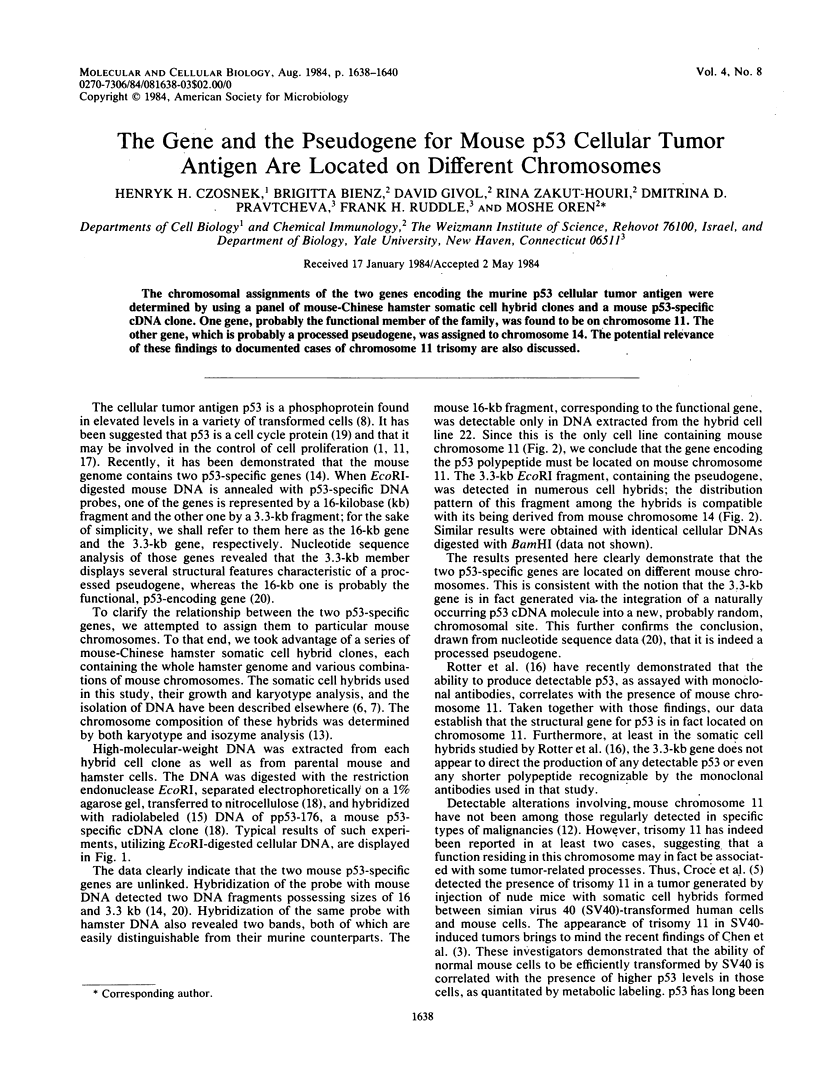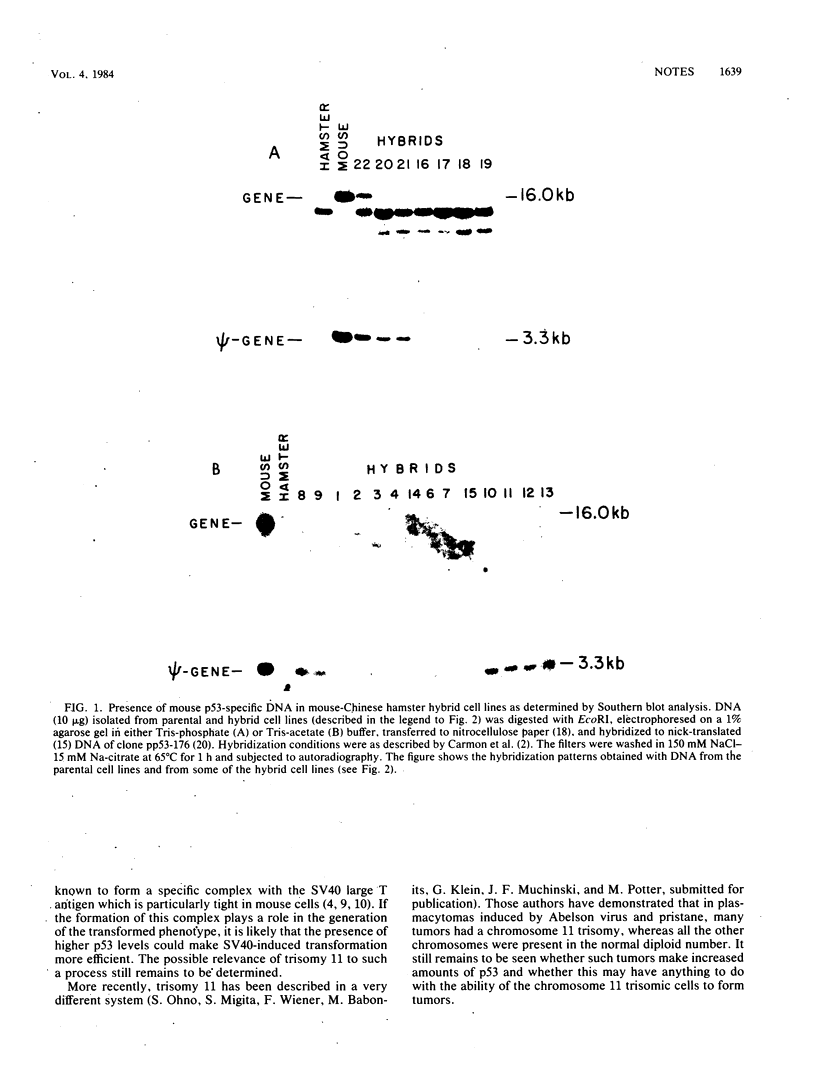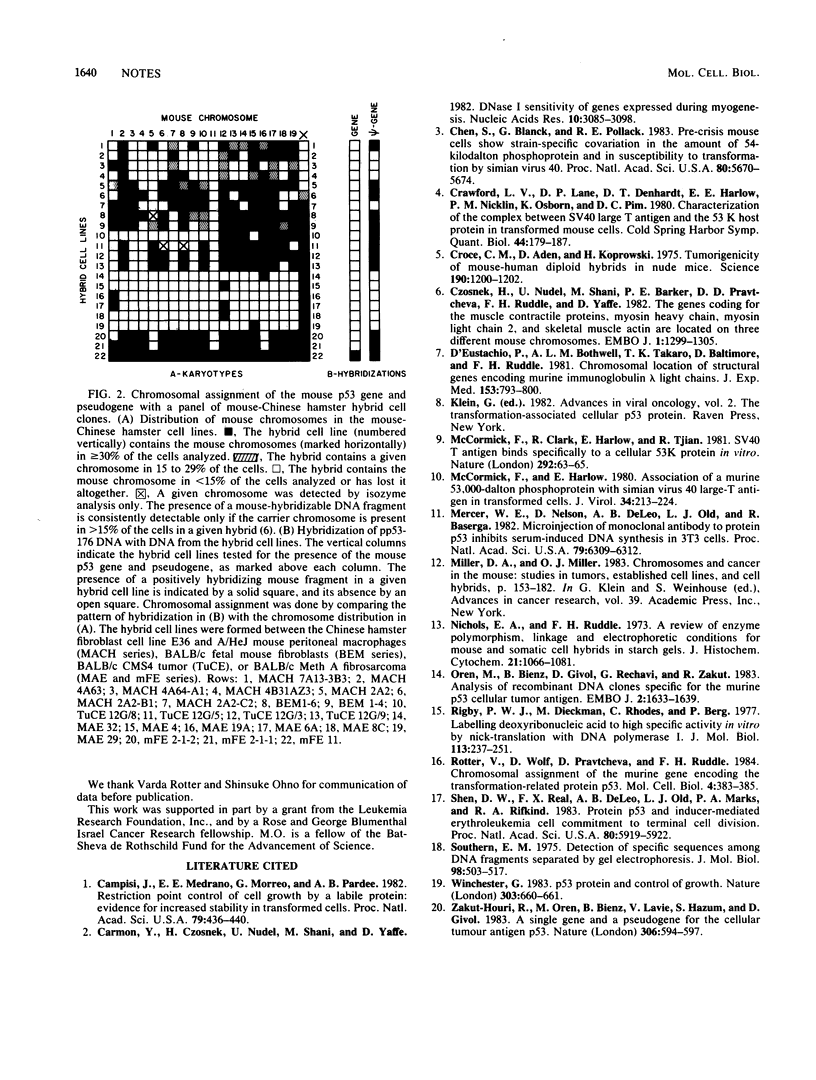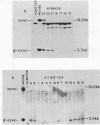Abstract
The chromosomal assignments of the two genes encoding the murine p53 cellular tumor antigen were determined by using a panel of mouse-Chinese hamster somatic cell hybrid clones and a mouse p53-specific cDNA clone. One gene, probably the functional member of the family, was found to be on chromosome 11. The other gene, which is probably a processed pseudogene, was assigned to chromosome 14. The potential relevance of these findings to documented cases of chromosome 11 trisomy are also discussed.
Full text
PDF


Images in this article
Selected References
These references are in PubMed. This may not be the complete list of references from this article.
- Campisi J., Medrano E. E., Morreo G., Pardee A. B. Restriction point control of cell growth by a labile protein: evidence for increased stability in transformed cells. Proc Natl Acad Sci U S A. 1982 Jan;79(2):436–440. doi: 10.1073/pnas.79.2.436. [DOI] [PMC free article] [PubMed] [Google Scholar]
- Carmon Y., Czosnek H., Nudel U., Shani M., Yaffe D. DNAase I sensitivity of genes expressed during myogenesis. Nucleic Acids Res. 1982 May 25;10(10):3085–3098. doi: 10.1093/nar/10.10.3085. [DOI] [PMC free article] [PubMed] [Google Scholar]
- Chen S., Blanck G., Pollack R. E. Pre-crisis mouse cells show strain-specific covariation in the amount of 54-kilodalton phosphoprotein and in susceptibility to transformation by simian virus 40. Proc Natl Acad Sci U S A. 1983 Sep;80(18):5670–5674. doi: 10.1073/pnas.80.18.5670. [DOI] [PMC free article] [PubMed] [Google Scholar]
- Crawford L. V., Lane D. P., Denhardt D. T., Harlow E. E., Nicklin P. M., Osborn K., Pim D. C. Characterization of the complex between SV40 large T antigen and the 53K host protein in transformed mouse cells. Cold Spring Harb Symp Quant Biol. 1980;44(Pt 1):179–187. doi: 10.1101/sqb.1980.044.01.021. [DOI] [PubMed] [Google Scholar]
- Croce C. M., Aden C., Koprowski H. Tumorigenicity of mouse-human diploid hybrids in nude mice. Science. 1975 Dec 19;190(4220):1200–1202. doi: 10.1126/science.173020. [DOI] [PubMed] [Google Scholar]
- Czosnek H., Nudel U., Shani M., Barker P. E., Pravtcheva D. D., Ruddle F. H., Yaffe D. The genes coding for the muscle contractile proteins, myosin heavy chain, myosin light chain 2, and skeletal muscle actin are located on three different mouse chromosomes. EMBO J. 1982;1(11):1299–1305. doi: 10.1002/j.1460-2075.1982.tb01314.x. [DOI] [PMC free article] [PubMed] [Google Scholar]
- D'Eustachio P., Bothwell A. L., Takaro T. K., Baltimore D., Ruddle F. H. Chromosomal location of structural genes encoding murine immunoglobulin lambda light chains. Genetics of murine lambda light chains. J Exp Med. 1981 Apr 1;153(4):793–800. doi: 10.1084/jem.153.4.793. [DOI] [PMC free article] [PubMed] [Google Scholar]
- McCormick F., Clark R., Harlow E., Tjian R. SV40 T antigen binds specifically to a cellular 53 K protein in vitro. Nature. 1981 Jul 2;292(5818):63–65. doi: 10.1038/292063a0. [DOI] [PubMed] [Google Scholar]
- McCormick F., Harlow E. Association of a murine 53,000-dalton phosphoprotein with simian virus 40 large-T antigen in transformed cells. J Virol. 1980 Apr;34(1):213–224. doi: 10.1128/jvi.34.1.213-224.1980. [DOI] [PMC free article] [PubMed] [Google Scholar]
- Mercer W. E., Nelson D., DeLeo A. B., Old L. J., Baserga R. Microinjection of monoclonal antibody to protein p53 inhibits serum-induced DNA synthesis in 3T3 cells. Proc Natl Acad Sci U S A. 1982 Oct;79(20):6309–6312. doi: 10.1073/pnas.79.20.6309. [DOI] [PMC free article] [PubMed] [Google Scholar]
- Miller D. A., Miller O. J. Chromosomes and cancer in the mouse: studies in tumors, established cell lines, and cell hybrids. Adv Cancer Res. 1983;39:153–182. doi: 10.1016/s0065-230x(08)61035-0. [DOI] [PubMed] [Google Scholar]
- Nichols E. A., Ruddle F. H. A review of enzyme polymorphism, linkage and electrophoretic conditions for mouse and somatic cell hybrids in starch gels. J Histochem Cytochem. 1973 Dec;21(12):1066–1081. doi: 10.1177/21.12.1066. [DOI] [PubMed] [Google Scholar]
- Oren M., Bienz B., Givol D., Rechavi G., Zakut R. Analysis of recombinant DNA clones specific for the murine p53 cellular tumor antigen. EMBO J. 1983;2(10):1633–1639. doi: 10.1002/j.1460-2075.1983.tb01637.x. [DOI] [PMC free article] [PubMed] [Google Scholar]
- Rigby P. W., Dieckmann M., Rhodes C., Berg P. Labeling deoxyribonucleic acid to high specific activity in vitro by nick translation with DNA polymerase I. J Mol Biol. 1977 Jun 15;113(1):237–251. doi: 10.1016/0022-2836(77)90052-3. [DOI] [PubMed] [Google Scholar]
- Rotter V., Wolf D., Pravtcheva D., Ruddle F. H. Chromosomal assignment of the murine gene encoding the transformation-related protein p53. Mol Cell Biol. 1984 Feb;4(2):383–385. doi: 10.1128/mcb.4.2.383. [DOI] [PMC free article] [PubMed] [Google Scholar]
- Shen D. W., Real F. X., DeLeo A. B., Old L. J., Marks P. A., Rifkind R. A. Protein p53 and inducer-mediated erythroleukemia cell commitment to terminal cell division. Proc Natl Acad Sci U S A. 1983 Oct;80(19):5919–5922. doi: 10.1073/pnas.80.19.5919. [DOI] [PMC free article] [PubMed] [Google Scholar]
- Southern E. M. Detection of specific sequences among DNA fragments separated by gel electrophoresis. J Mol Biol. 1975 Nov 5;98(3):503–517. doi: 10.1016/s0022-2836(75)80083-0. [DOI] [PubMed] [Google Scholar]
- Winchester G. p53 protein and control of growth. Nature. 1983 Jun 23;303(5919):660–661. doi: 10.1038/303660a0. [DOI] [PubMed] [Google Scholar]
- Zakut-Houri R., Oren M., Bienz B., Lavie V., Hazum S., Givol D. A single gene and a pseudogene for the cellular tumour antigen p53. Nature. 1983 Dec 8;306(5943):594–597. doi: 10.1038/306594a0. [DOI] [PubMed] [Google Scholar]



